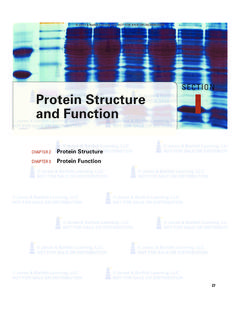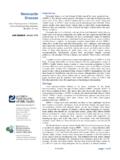Transcription of Chemistry for peptide and protein PEGylation M.J. …
1 Advanced Drug Delivery Reviews 54 (2002) 459 / locate / drugdelivChemistry for peptide and protein PEGylation * Roberts , Bentley, HarrisShearwater Corporation, 490 Discovery Drive,Huntsville,AL35806,USAR eceived 17 December 2001; accepted 22 January 2002 AbstractPoly(ethylene glycol) (PEG) is a highly investigated polymer for the covalent modification of biological macromoleculesand surfaces for many pharmaceutical and biotechnical applications. In the modification of biological macromolecules, peptides and proteins are of extreme importance. Reasons for PEGylation ( the covalent attachment of PEG) of peptidesand proteins are numerous and include shielding of antigenic and immunogenic epitopes, shielding receptor-mediated uptakeby the reticuloendothelial system (RES), and preventing recognition and degradation by proteolytic enzymes.
2 PEGconjugation also increases the apparent size of the polypeptide, thus reducing the renal filtration and altering important aspect of PEGylation is the incorporation of various PEG functional groups that are used to attach the PEG tothe peptide or protein . In this paper, we review PEG Chemistry and methods of preparation with a particular focus on new(second-generation) PEG derivatives, reversible conjugation and PEG structures. 2002 Elsevier Science All : PEGylation ; PEG- protein ; PEG conjugation; PEG chemistryContents1. Introduction ..4602. Properties of PEG ..4603. Chemistry of First-generation PEG PEG Chemistry for amine conjugation .. Second-generation PEGylation PEG Chemistry for amine conjugation .. PEG Chemistry for cysteine modification .. PEG Chemistry for oxidized carbohydrates or N-terminus.
3 PEG Chemistry for reversible PEGylation .. Heterobifunctional PEG Chemistry .. PEG structures ..4734. Conclusions ..474 References ..474*Corresponding author. Tel.:11-256-704-7524; ( Roberts).0169-409X / 02 / $ see front matter 2002 Elsevier Science All rights : S0169-409X(02) et Drug Delivery Reviews54 (2002) 459 4761. Introductiontached to the polypeptide, (3) the location of thePEG sites on the polypeptide and (4) the chemistryThe use of proteins and peptides as human thera-used to attach the PEG to the has expanded in recent years due to: (1)The importance of Chemistry and quality of PEGdiscovery of novel peptides and proteins, (2) a betterreagents for peptide and protein modification hasunderstanding of the mechanism of action in vivo,only been realized in the last several years as more(3) improvements in expression or synthesis ofand more PEG-conjugates have reached late phaseproteins and peptides that closely resemble fullyclinical trials.
4 The first few PEG- protein products, human proteins and peptides , and (4) improvementsnow on the market (Adagen , Oncospar , and PEG- in formulation or molecule-altering technologies thatIntron ), were developed using first generation PEGhave the ability to deliver polypeptides in vivo withchemistry. One characteristic of first generation PEGimproved pharmacokinetic and pharmacodynamicchemistry is the use of low molecular weight linearproperties. It was estimated that in the year 2000, asPEGs (#12 kDa) with Chemistry that may result inmany as 500 biopharmaceutical products were under-side reactions or weak linkages upon conjugationgoing clinical trials, and the estimated annual growthwith (glycoproteins,un-The next generation of PEG- protein therapeutics,glycosylated proteins and antibodies) will range fromwhich will come to market in the next several years,10 to 35% [1].
5 Uses second-generation PEG chemistries. Second-Although more biopharmaceuticals are in develop-generation PEGylation was designed to avoid thement than ever before, many of these have problemsproblems of first generation Chemistry , notablythat are typical of polypeptide therapeutics, includingdiactivated PEG impurities, restriction to low molec-shortcirculatinghalf-life,immunoge nicity,ular weight mPEG, unstable linkages and lack ofproteolytic degradation, and low solubility. Severalselectivity in modification. Readers are referred tostrategies have emerged as ways to improve theseveral detailed reviews on different aspects ofpharmacokinetic and pharmacodynamic properties ofPEGylation [7 11]. In this paper, we review chemis-biopharmaceuticals, including: (1) manipulation oftries of both first- and second-generation, with anamino acid sequence to decrease immunogenicityemphasis on newer PEGylation technologies, inand proteolytic cleavage, (2) fusion or conjugation toorder to provide an introduction to those chemistriesimmunoglobulins and serum proteins, such as al-that will be used in the following , (3) incorporation into drug delivery vehiclesfor protection and slow release, and (4) conjugatingto natural or synthetic polymers [2 6].
6 2. Properties of PEGT hose in the biomedical, biotechnical and pharma-ceutical communities have become quite familiarIn its most common form poly(ethylene glycol),with the improved pharmacological and biologicalPEG, is a linear or branched polyether terminatedproperties that are associated with the covalentwith hydroxyl groups and having the general struc-attachment of poly(ethylene glycol) or PEG toture:therapeutically useful polypeptides. For instance,PEG conjugation can shield antigenic epitopes of theHO (CH CH O) CH CH OH22n22polypeptide, thus reducing reticuloendothelial (RES)clearance and recognition by the immune system andPEG is synthesized by anionic ring openingalso reducing degradation by proteolytic of ethylene oxide initiated by nu-PEG conjugation also increases the apparent size ofcleophilic attack of a hydroxide ion on the epoxidethe polypeptide, thus reducing renal filtration andring.
7 Most useful for polypeptide modification isaltering biodistribution. Contributing factors thatmonomethoxy PEG, mPEG, having the generalaffect the foregoing properties are: (1) the number ofstructure:PEG chains attached to the polypeptide, (2) themolecular weight and structure of PEG chains at-CH O (CH CH O) CH CH et Drug Delivery Reviews54 (2002) 459 476461 Monomethoxy PEG is synthesized by anionic ringas if it were five to 10 times as large as a solubleopening polymerization initiated with methoxideprotein of comparable molecular weight. Theseions. Commercially available mPEG contains afactors have been suggested as the reason that PEGconsiderable amount of diol PEG due to the presenceexhibits the ability to precipitate proteins [15],of trace amounts of water during proteins and cells from surfaces [16], reduceThis diol PEG is also of relatively high molecularimmunogenicity and antigenicity [17] and preventweight due to polymerization at both ends of thedegradation by mammalian cells and enzymes [18].
8 Polymer. The amount of diol PEG can exceed 15%Low molecular weight oligomers of PEG (,400of the composition of mPEG. A solution to theDa) have been shown to be degraded in vivo byproblem of diol contamination has been developed inalcohol dehydrogenase to toxic metabolites, howeverour laboratories [12]. In this work, a crude benzylox-the lack of toxicity of PEGs with a molecular weighty-PEG, containing diol impurity, is methylated andabove 1000 Da has been revealed over many years ofthen hydrogenated to remove the benzyl group. Thususe in foods, cosmetics and pharmaceuticals [18].diol is converted to the inert dimethyl ether, whichPEG is rapidly cleared in vivo without structuralcan be subsequently removed after activation andchange and clearance is dependent on molecularpolypeptide Below a molecular weight of about 20 kDathe molecule is cleared in the urine, and higherBzO PEG OH1HO PEG OH HO PEG molecular weight PEGs are cleared more slowly inOCH1CH O PEG OCHthe urine and feces.
9 PEG is only weakly immuno-333genic even at high molecular weights. Antibodies toAnother common route to remove diol is toPEG have been generated when attached to a highlyconvert the PEGs to PEG-carboxylic acids that canimmunogenic molecule under an immunizationthen be purified by ion-exchange chromatographyprotocol with Freund s adjuvant [19 21]. There are[13]. PEG with various end groups can be preparedno known situations in which anti-PEG antibodiesby use of suitable initiator and / or termination re-have been generated under normal clinical adminis-agents. Numerous functionalities can be introducedtration of a PEG-modified end groups on PEG in this manner, includingheterobifunctional products. For instance, Kataoka etal.
10 Synthesized a heterobifunctional PEG derivative3. Chemistry of pegylationcontaining aldehyde and thiol end groups [14].Polymerization was initiated with 3,3-diethoxy-1-To couple PEG to a molecule ( polypeptides,propanol, which forms a propionaldehyde after acidpolysaccharides, polynucleotides and small organichydrolysis, and the polymerization was terminatedmolecules) it is necessary to activate the PEG bywith methansulfonyl chloride with successive con-preparing a derivative of the PEG having a func-version to ethyldithiocarbonate and a free group at one or both termini. The functionalCompared with other polymers, PEG has a rela-group is chosen based on the type of availabletively narrow polydispersity (M/M) in the range ofreactive group on the molecule that will be for low molecular weight PEGs (,5 kDa) toto the PEG.







